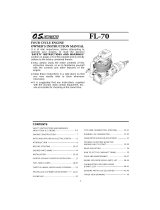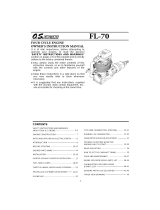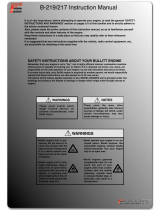OS Engines OSMG1160 Owner's manual
- Category
- Engine
- Type
- Owner's manual
OS Engines OSMG1160 is a flat-twin four-stroke engine designed for use in model aircraft. It is a powerful and reliable engine that is capable of delivering excellent performance. The engine features a horizontally-opposed twin-cylinder design, which provides smooth and balanced operation. It also has an overhead-valve design, which allows for efficient combustion and increased power output. The engine is constructed from high-quality materials and is built to last. It is also easy to maintain and service, making it a great choice for both experienced and novice modelers.
The OS Engines OSMG1160 is a versatile engine that can be used in a variety of model aircraft, including scale models, sport models, and aerobatic models. It is also a great choice for use in trainers, as it is easy to start and operate. The engine comes with a comprehensive instruction manual that provides all the information you need to get started.
OS Engines OSMG1160 is a flat-twin four-stroke engine designed for use in model aircraft. It is a powerful and reliable engine that is capable of delivering excellent performance. The engine features a horizontally-opposed twin-cylinder design, which provides smooth and balanced operation. It also has an overhead-valve design, which allows for efficient combustion and increased power output. The engine is constructed from high-quality materials and is built to last. It is also easy to maintain and service, making it a great choice for both experienced and novice modelers.
The OS Engines OSMG1160 is a versatile engine that can be used in a variety of model aircraft, including scale models, sport models, and aerobatic models. It is also a great choice for use in trainers, as it is easy to start and operate. The engine comes with a comprehensive instruction manual that provides all the information you need to get started.


















-
 1
1
-
 2
2
-
 3
3
-
 4
4
-
 5
5
-
 6
6
-
 7
7
-
 8
8
-
 9
9
-
 10
10
-
 11
11
-
 12
12
-
 13
13
-
 14
14
-
 15
15
-
 16
16
-
 17
17
-
 18
18
OS Engines OSMG1160 Owner's manual
- Category
- Engine
- Type
- Owner's manual
OS Engines OSMG1160 is a flat-twin four-stroke engine designed for use in model aircraft. It is a powerful and reliable engine that is capable of delivering excellent performance. The engine features a horizontally-opposed twin-cylinder design, which provides smooth and balanced operation. It also has an overhead-valve design, which allows for efficient combustion and increased power output. The engine is constructed from high-quality materials and is built to last. It is also easy to maintain and service, making it a great choice for both experienced and novice modelers.
The OS Engines OSMG1160 is a versatile engine that can be used in a variety of model aircraft, including scale models, sport models, and aerobatic models. It is also a great choice for use in trainers, as it is easy to start and operate. The engine comes with a comprehensive instruction manual that provides all the information you need to get started.
Ask a question and I''ll find the answer in the document
Finding information in a document is now easier with AI
Related papers
-
OS Engines OSMG1320 Owner's manual
-
OS Engines FT-160 User manual
-
OS Engines OSMG1307 Owner's manual
-
OS Engines OSMG0935 Owner's manual
-
OS Engines OSMG0575 Owner's manual
-
OS Engines OSMG0877 Owner's manual
-
OS Engines OSMG0900 Owner's manual
-
OS Engines OSMG0557 Owner's manual
-
O.S. Engines OSMG0898 Owner's manual
-
OS Engines MAX-10LA Owner's manual
Other documents
-
O.S. engine fs-120sIII Owner's Instruction Manual
-
O.S. engine MAX-32SX-MX Owner's Instruction Manual
-
O.S. engine max-140rx Owner's manual
-
 Hobbico FL-70 Owner's manual
Hobbico FL-70 Owner's manual
-
O.S. engine MAX-32SX Owner's Instruction Manual
-
 Hobbico FL-70 Owner's manual
Hobbico FL-70 Owner's manual
-
 Bullitt B-217 User manual
Bullitt B-217 User manual
-
O.S. engine 25LA-S Owner's Instruction Manual
-
Magnum XL .30RFS Operating Instructions Manual
-
Generac MAX-12CV HyperMAX-12CV-X Hyper User manual




















